I have done my best and here is my solution.
The code for the QStyledItemDelegate subclass is mostly from here.
Solution Picture

However, there is one things I am curious to fix: (maybe someone can help me and left a comment)
QPixmap::grabWidget is deprecated, use QWidget::grab() instead but it looks like QWidget::grab() is not the right solution for this purpose.
foo.h:
#ifndef LIBRARYITEMDELEGATE_H
#define LIBRARYITEMDELEGATE_H
#include <QStyledItemDelegate>
#include <QWidget>
#include <QPushButton>
#include <QTableView>
class LibraryItemDelegate : public QStyledItemDelegate
{
Q_OBJECT
public:
explicit LibraryItemDelegate(QObject *parent = 0);
~LibraryItemDelegate();
void paint(QPainter *painter, const QStyleOptionViewItem &option, const QModelIndex &index) const Q_DECL_OVERRIDE;
// QSize sizeHint(const QStyleOptionViewItem &option, const QModelIndex &index) const Q_DECL_OVERRIDE;
QWidget *createEditor(QWidget *parent, const QStyleOptionViewItem &option, const QModelIndex &index) const Q_DECL_OVERRIDE;
void setEditorData(QWidget *editor, const QModelIndex &index) const Q_DECL_OVERRIDE;
void setModelData(QWidget *editor, QAbstractItemModel *modal, const QModelIndex &index) const Q_DECL_OVERRIDE;
void updateEditorGeometry(QWidget *editor, const QStyleOptionViewItem &option, const QModelIndex &index) const Q_DECL_OVERRIDE;
public slots:
void cellEntered(const QModelIndex &index);
private:
QTableView *myView;
QPushButton *btn;
bool isOneCellInEditMode;
QPersistentModelIndex currentEditedCellIndex;
};
#endif // LIBRARYITEMDELEGATE_H
foo.cpp:
#include "libraryitemdelegate.h"
#include <QPainter>
#include <QStylePainter>
LibraryItemDelegate::LibraryItemDelegate(QObject *parent) : QStyledItemDelegate(parent)
{
if(QTableView *tableView = qobject_cast<QTableView*>(parent))
{
myView = tableView;
btn = new QPushButton("...", myView);
btn->hide();
myView->setMouseTracking(true);
connect(myView, SIGNAL(entered(QModelIndex)), this, SLOT(cellEntered(QModelIndex)));
isOneCellInEditMode = false;
}
}
LibraryItemDelegate::~LibraryItemDelegate(){}
void LibraryItemDelegate::paint(QPainter *painter, const QStyleOptionViewItem &option, const QModelIndex &index) const
{
if(index.model()->headerData(index.column(), Qt::Horizontal, Qt::UserRole).toInt() == 1)
{
btn->setGeometry(option.rect);
btn->setText("...");
if(option.state == QStyle::State_Selected)
{
painter->fillRect(option.rect, option.palette.highlight());
}
QPixmap map = QPixmap::grabWidget(btn);
painter->drawPixmap(option.rect.x(), option.rect.y(), map);
}
else
{
QStyledItemDelegate::paint(painter, option, index);
}
}
//QSize LibraryItemDelegate::sizeHint(const QStyleOptionViewItem &option, const QModelIndex &index) const
//{
// // return the QSize of the item in Your view
//}
QWidget *LibraryItemDelegate::createEditor(QWidget *parent, const QStyleOptionViewItem &option, const QModelIndex &index) const
{
if(index.model()->headerData(index.column(), Qt::Horizontal, Qt::UserRole).toInt() == 1)
{
QPushButton *btn = new QPushButton(parent);
// btn->setText(index.data().toString());
btn->setText("...");
return btn;
}
else
{
return QStyledItemDelegate::createEditor(parent, option, index);
}
}
void LibraryItemDelegate::setEditorData(QWidget *editor, const QModelIndex &index) const
{
if(index.model()->headerData(index.column(), Qt::Horizontal, Qt::UserRole).toInt() == 1)
{
QPushButton *btn = qobject_cast<QPushButton*>(editor);
// btn->setProperty("data_value", index.data());
btn->setProperty("data_value", "...");
btn->setText("...");
}
else
{
QStyledItemDelegate::setEditorData(editor, index);
}
}
void LibraryItemDelegate::setModelData(QWidget *editor, QAbstractItemModel *model, const QModelIndex &index) const
{
if(index.model()->headerData(index.column(), Qt::Horizontal, Qt::UserRole).toInt() == 1)
{
QPushButton *btn = qobject_cast<QPushButton*>(editor);
model->setData(index, btn->property("data_value"));
}
else
{
QStyledItemDelegate::setModelData(editor, model, index);
}
}
void LibraryItemDelegate::updateEditorGeometry(QWidget *editor, const QStyleOptionViewItem &option, const QModelIndex &index) const
{
editor->setGeometry(option.rect);
}
void LibraryItemDelegate::cellEntered(const QModelIndex &index)
{
if(index.model()->headerData(index.column(), Qt::Horizontal, Qt::UserRole).toInt() == 1)
{
if(isOneCellInEditMode)
{
myView->closePersistentEditor(currentEditedCellIndex);
}
myView->openPersistentEditor(index);
isOneCellInEditMode = true;
currentEditedCellIndex = index;
}
else
{
if(isOneCellInEditMode)
{
isOneCellInEditMode = false;
myView->closePersistentEditor(currentEditedCellIndex);
}
}
}
Implementation:
QStandardItemModel *myModel; // This is in the Header file
myModel = new QStandardItemModel(0,2,this);
myModel->setHeaderData(1, Qt::Horizontal, 1, Qt::UserRole);
myModel->setHorizontalHeaderLabels(QStringList(tr("Pfad zu den bibliotheks Ordnern")));
// Set Model and delegate to the View
ui->tableView_pathes->setModel(myModel);
LibraryItemDelegate *delegate = new LibraryItemDelegate(ui->tableView_pathes);
ui->tableView_pathes->setItemDelegate(delegate);
// Stretch only the first column
ui->tableView_pathes->horizontalHeader()->setSectionResizeMode(0,QHeaderView::Stretch);
ui->tableView_pathes->horizontalHeader()->setSectionResizeMode(1,QHeaderView::Fixed);
Edit: Here is the code for the buttons in the tableView. Connect the signals in createEditor with connect(btn, SIGNAL(pressed()), this, SLOT(buttonPressed())); and set give the delegate a reference to the QStandardItemModel.
void LibraryItemDelegate::buttonPressed()
{
QString dir = QFileDialog::getExistingDirectory(new QWidget(), tr("Wähle die bibliotheks Ordner"), "/home", QFileDialog::ShowDirsOnly);
qDebug() << "Test: " << dir;
if(!dir.isEmpty())
{
QModelIndex ind = currentEditedCellIndex.model()->index(currentEditedCellIndex.row(), 0);
myModel->setData(ind, dir, Qt::DisplayRole);
}
}
